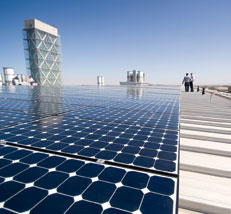KAUST
An ambitious plan for a world-class research university in Saudi Arabia's desert spurs an unprecedented building project.
![]() Continuing Education
Continuing Education
Use the following learning objectives to focus your study while reading this month’s Continuing Education article.
Learning Objectives - After reading this article, you will be able to:
- Explain the challenges KAUST's site presented in its design and construction.
- Describe the challenges KAUST's program presented in its design and construction.
- Identify passive-sustainable-design strategies used at KAUST.
- Describe how and why traditional Arabic design elements were incorporated into KAUST's contemporary design.
It seemed like a far-fetched idea. Build a world-class research university from scratch on the edge of the desert that would contain state-of-the-art facilities and be an exemplar of sustainable design. And do it in under three years. But since the idea belonged to Saudi Arabia's King Abdullah bin Abdulaziz Al Saud, it got done. The result is King Abdullah University of Science and Technology, known by its acronym, KAUST.
Getting it done required the intense collaboration of architects, designers, engineers, builders, and suppliers around the world. With 24 offices in North America, Europe, Asia, and the Middle East, HOK was in a unique position to coordinate the job. By coincidence or not, it had also designed Saudi Arabia's first large-scale university, King Saud University in Riyadh, more than 30 years earlier - at the time (1975-83) considered the single largest building-construction project in the world. Originally hired in October 2006 to do a master plan for KAUST, which included a commercial center, a research park, and residential areas for the school's students and staff, HOK was awarded the commission for the architectural, landscape, structural, m/e/p, interior, and lighting design of the campus's 23 buildings in March 2007.
Located along the coast of the Red Sea in Thuwal, home to a small fishing village about 30 miles north of Jeddah, KAUST's 5.5-million-square-foot campus would spread out over 100 acres in one of the world's most extreme climates. On the one hand, its design had to mitigate the intense sun and ubiquitous sand of the desert. On the other, it had to contend with the high humidity and unusually high salinity of the marine site, which included a unique coral reef ecosystem that required protection.
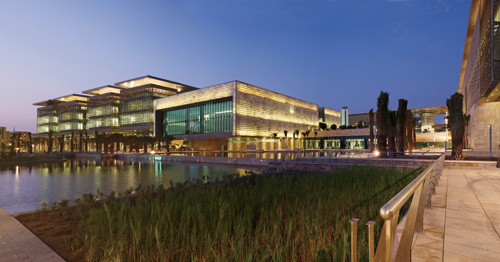 |
KAUST's glowing library sits between the commons and several lab buildings. Behind it is the oval-shaped rotunda. Photo: © JB Picoulet |
The site itself needed improving from a geotechnical point of view. So while work on the master plan was being completed, 42,000 stone columns were being drilled into the ground to stabilize the soil and bring it to a condition that could support the weight of the buildings, the designs for which had only just begun at that point. Engineers arrayed 30-inch-diameter holes on a 5-foot-on-center grid that covered the horseshoe-shaped campus. Crushed limestone was injected under high pressure, typically 25 feet deep, into the openings. "It's a unique upgrading process that has been used elsewhere, but never at this magnitude or speed," says Ed Abboud, a structural engineer in HOK's Houston office, which shared the primary design role with HOK's founding office in St. Louis.
 |
A sea court fronts the white stone-glass-clad library, which appears opaque during the day, but glows at night. Photo: © JB Picoulet |
Â
With site preparations under way, and after several weeks of separate groups working somewhat independently, HOK gathered design leaders for a three-week-long focused design effort. During this period, the firm established design principles and a strategy for carrying them out. "We created a structure that stratified work not by building or typology but by ground plane, middle plane, and roof plane," explains Jeff Ryan, AIA. "Ten percent of the design would be of special structures that have a strong character and give identity to the campus. The rest would be elegant background - quiet, but extremely well-crafted buildings."
The buildings also needed to be extremely flexible since the university's program was being worked out concurrently with the design. This, and the project's condensed time frame, led to buildings with a largely modular design with many repetitive features. Paris-based Oger International, whose work in Saudi Arabia until this point consisted mainly of constructing opulent palaces, came on board as the contractor. Members of its team, which included architects and engineers, relocated to HOK's St. Louis office for six months at a time during design development.
Just as HOK proposed certifying the project through LEED to senior staff at Aramco - the state-owned oil company commissioned by the king to act as the project manager because of its experience doing large, complex projects - the client revealed that the graduate-level university would focus its research on postpetroleum sciences, including sustainable agriculture, next-generation photovoltaics, and other urgent challenges related to energy and the environment.
The multistory lab buildings - rendered taller by the 10-foot-high interstitial spaces between lab floors that allow a variety of layouts to be serviced mechanically over time - are the most prominent on the campus, containing a total of 48 research neighborhoods fitted out to meet the needs of individual professors as they are hired. Flanking the campus's core, the clustered buildings' latticelike terra-cotta cladding alludes to the mashrabiya screen, one of several traditional Arabic elements incorporated into both the campus and building design for aesthetic and environmental reasons.
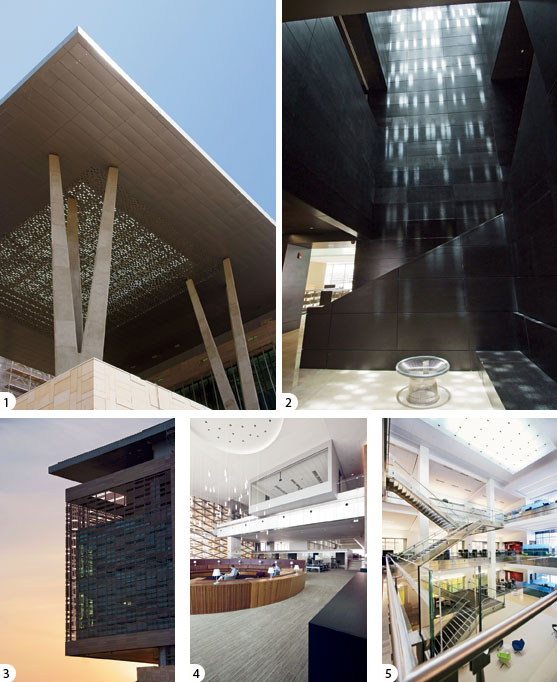 |
1. A large roof supported by treelike columns shades the plaza leading into the pedestrian spine. KAUST's roof system alludes to Bedouin tent design by blocking out the intense sun and encouraging airflow. Photos: © JB Picoulet |
Â
At the heart of the campus, around the main quad, are conventional academic buildings, including classroom and administrative buildings, an auditorium, and a conference center. The rotunda - a tall, oval-shaped, glazed exhibition space supported by diagrid steel bracing - represents one of the campus's special objects, along with the stone-glass-clad library and a pair of slender, rectangular solar towers. A diagrid structure, not always steel, became a unifying strategy for these unique elements. Other such elements, like the entry pavilions for the pedestrian spine, feature lofty roofs and treelike columns to express its singularity.
While KAUST's campus design shares much in common with American universities, familiar to many of Aramco's employees who studied in the United States, the contemporary campus aesthetic is grounded in historical building precedent. HOK looked to the compressed buildings and covered spaces of traditional Middle Eastern cities when laying out the campus and designing its features, creating closely knit buildings with protective roofs, or, as HOK refers to it, a singular megabuilding linked by a number of interior and exterior courtyards, improving proximities among researchers, faculty, and students in the hot and humid climate.
Based on energy modeling HOK conducted with environmental consultants RWDI, it determined that this approach, which minimized the amount of exterior envelope exposed to the sun, would result in an approximate 10 to 15 percent decrease in energy use compared to a layout in which buildings were spread out and exposed on all sides. Building orientations also limit harsh eastern and western sun exposure while taking advantage of prevailing Red Sea winds to act as a cooling mechanism.
Like a traditional souk, or market, the layout also promotes greater social activity by providing a shaded pedestrian zone. This active outdoor concourse houses conference, meeting, office, and retail space while bisecting and interconnecting all research buildings. HOK designed the pedestrian area to be accessible not only to wheelchairs and carriages, but to Segways - an increasingly popular method of getting around campus, and to and from the residential areas less than a mile away.
The marine site's saline environment is highly corrosive to steel, and limited its use to only select elements that could be encapsulated. The buildings' primary structure is cast-in-place concrete, the construction of which draws from a labor pool that is abundant in the area. During construction, the site was home to three concrete-batch plants and one precast plant that allowed work to proceed throughout the day and night and eliminated the need to bring material in from afar (the closest town capable of providing it is an hour away).
| Site Plan | AÂ Â University Campus |
 |
Â
"In the middle of our first meeting with Oger once they came on board, members of their team got on the phone to tie up all the cranes they could get," recalls HOK's Bill O'Dell. "They knew it would have been impossible if they waited because of all the construction in the region at the time." Midway through construction of KAUST, Oger introduced precast concrete to save time. Though cement replacement for high-performance concrete is preferred when building environmentally sensitive structures, according to HOK, more sustainable substitutes like fly ash and silica fume were not readily available in the kingdom.
| Main Floor Plan | 1Â Â Main Quad |
|
 |
||
Â
Since aluminum fares better than steel in this environment and does not require as skilled a labor force, it was used extensively in the shading roofs and special space-frame structures. Concrete trusses in the Applied Mathematics Building are used to achieve a 55-foot cantilever, shading pedestrian areas below it. Several other buildings use sheer walls for smaller cantilevers, averaging around 30 feet. All steel rebar was treated with a special epoxy coating.
To ensure that future rising sea levels and changing climate patterns do not adversely affect the campus - designed as a 100-year building - work crews elevated the site by adding 8 feet of soil, creating a massive plinth. The plinth includes the lower stone walls of the campus buildings as well as the stone horizontal surfaces that make up the plaza and courtyard hardscapes. Between the plinth and the shading roof, which in some areas spans up to 195 feet, the restrained, earth-toned building faces reside. These terra-cotta enclosures are distinguished from the stone plinth by a window ribbon of glass. Integral solar shading over most of the facades reduces heat loads and creates dappled light in building interiors.

|
||||
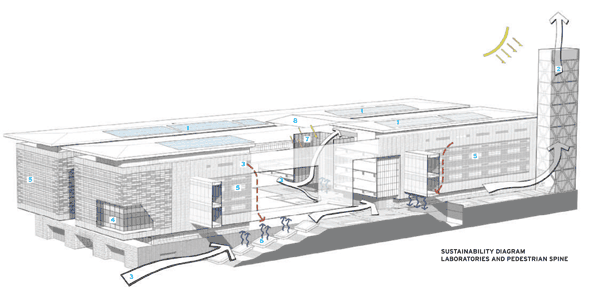 |
||||
Â
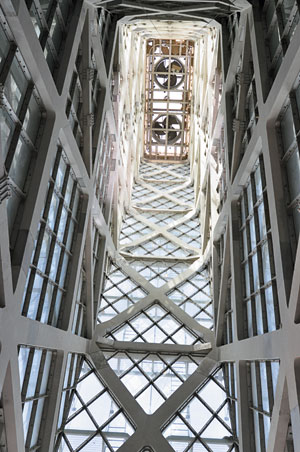 |
Two 195-foot-tall solar towers act like chimneys to ventilate the courtyard spaces between lab buildings. A high-strength, precast-concrete diagrid frame supports two layers of glass. The sun heats the air within the tower to draw it upward. Fans at the top provide supplemental airflow. Photo: © JB Picoulet |
The roof is articulated as a monumental floating plane hovering above all the buildings. Much of its upper surface's 900,000 square feet is covered in an array of large solar-photovoltaic and solar-thermal panels. While the combination of these two systems provides just 7.8 percent of the total energy required to operate the campus, as the faculty and student population increases - the 2009 inaugural academic year consisted of 72 faculty and 374 students, but those numbers are expected to reach 600 and 2,000, respectively - future plans call for the creation of a solar farm to harness much more of the sun's potential. Because the sun is so intense on the site, how the campus addresses the sun's energy is a key part of KAUST's sustainable strategy.
The design team employed primarily passive solutions, including building placement and orientation, shading, and daylighting, to achieve much of the campuswide energy reduction. "Sustainable design is passive first," says Duncan Phillips of RWDI. "If we have to introduce a system to solve something, it's because we haven't solved it passively."
At KAUST, many of the sustainable strategies are invisible, but two very prominent sustainable features are the 195-foot-tall solar towers, which have become campus icons. (The only other nearby vertical element is the campus mosque's smaller minaret.) The glazed towers serve an important, mostly passive, role in terms of comfort by ventilating the courtyard spaces between the lab clusters. More important, from a safety perspective, since some of the labs are expected to be wet labs where chemicals and biological materials are tested, designers had to ensure that the particles that come out of those labs do not go back into the buildings. The towers act as chimneys in which the sun and wind work together to draw the tainted air out. Dampers located near the top of the towers regulate airflow and prevent downdraft in negative pressure conditions. Fans provide supplemental airflow under extreme demands. The labs also utilize a heat-recovery ventilation system to provide fresh air while saving energy.
Project Credits
Project:King Abdullah University of Science and Technology (KAUST), Thuwal, Saudi Arabia Sources
Concrete: GRC System Building |
A comprehensive irrigation plan allocates water-reclamation loads from condensate, storm, gray, and black water to satisfy a majority of the irrigation requirements, which would have been less if HOK's original xeriscaping design was implemented. An on-site desalination plant creates potable water from the sea, though the process is energy-intensive.
Since opening its doors in September 2009, KAUST has become the first built project in Saudi Arabia to achieve LEED certification, and the largest in the world to attain LEED Platinum. Though this is a major accomplishment in some respects, and definitely a step in the right direction for a country whose oil-based economy has served it very well until now, there is an inherent irony in the story. Creating a city out of nothing so remote from much of its own country's population, and farther still from the professors and students with whom it wishes to collaborate, defies the very notion of sustainability. Filling the campus with high-energy-intensity lab buildings - despite the well-intentioned research conducted within them - in one of the world's most extreme climates, seems counterintuitive; blanketing parts of its desert site in turf grass and adding a golf course, downright absurd.
These were decisions beyond HOK's control. It was charged with making the design, construction, and operation of the buildings themselves as sustainable as possible within the project's accelerated time frame. Despite the fact that construction of the buildings used more than 16 million cubic feet of conventional concrete and all of the buildings' interior spaces require air-conditioning, the project still managed to garner the highest possible LEED rating, which speaks to obvious shortcomings of LEED, not HOK's sustainable-design efforts. KAUST's administrative buildings are said to use up to 40 percent less energy than the U.S. standard, its lab buildings 20 to 25 less - statistics that clearly point to deficiencies in construction here in the United States, not in Saudi Arabia.
| MAKING IT WORK | |||||
A fast-track project for a desert startup led to collaboration around the globe. Abbie Gregg is the owner of AGI, an Arizona-based firm that provides engineering and consulting services for advanced technology industries. She and her staff traveled frequently to Saudi Arabia to provide on-site support for construction of KAUST's state-of-the-art research and laboratory facilities. Josephine Minutillo: How did you get involved with KAUST? JM: You traveled there much more than the architects did. Why? JM: What were the specific challenges of being a woman on this job? JM: Was it difficult then for some of the men who are not used to working with women to collaborate with your team? JM: Would you do it again? |
|||||

